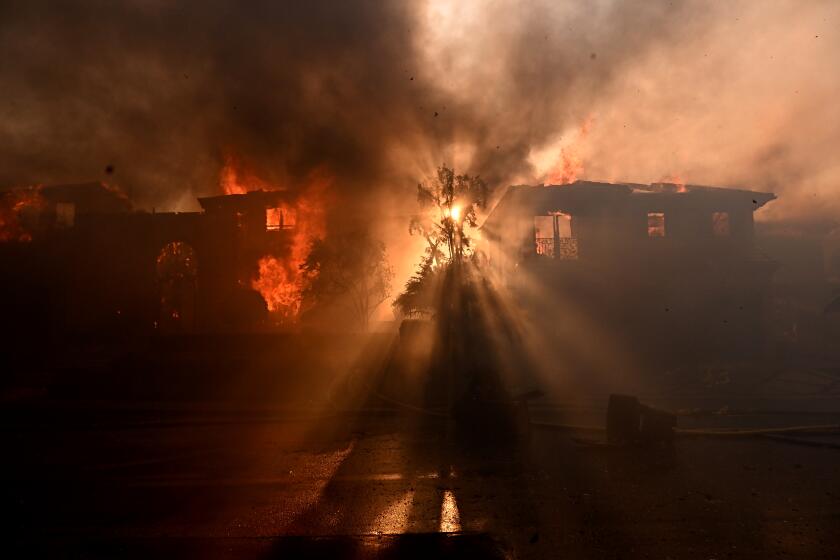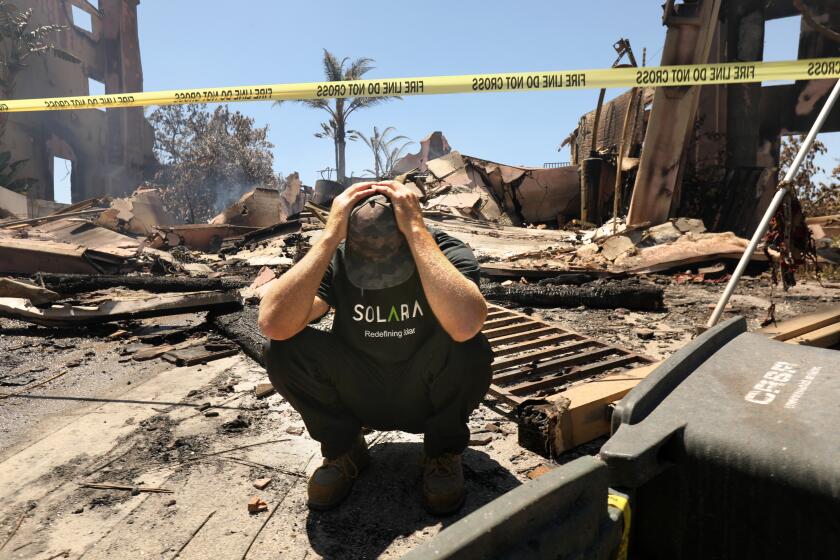‘Utter chaos’: How the Coastal fire destroyed O.C. mansions despite firefighters’ efforts
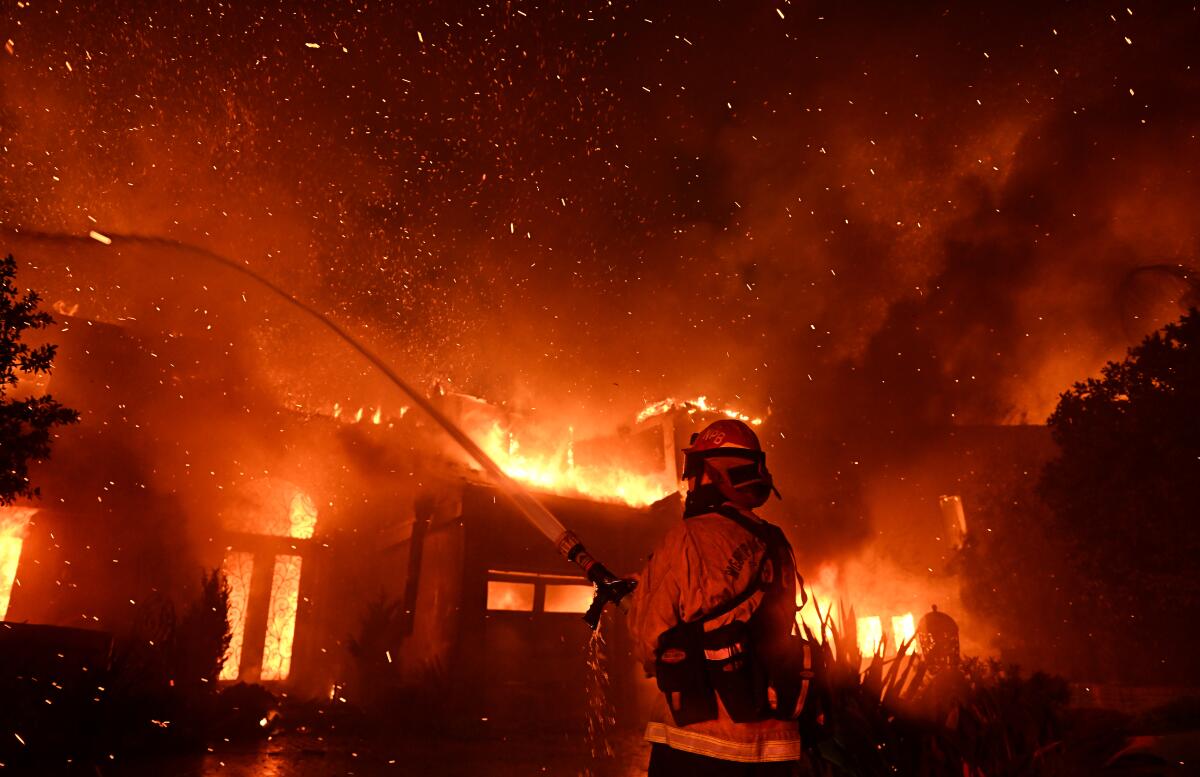
- Share via
Andreas Frank watched from the second story of his ridge-top Laguna Niguel home as the hillside below began to smolder.
It was May 11, and his partner, Kamal Al-Faqih, was in the backyard grilling ribs in preparation for their nephew’s high school graduation party.
Frank banged on the window and pointed toward the smoke in nearby Aliso Woods Canyon.
Six minutes later — at 2:49 p.m. — the flames had grown, jumping to an adjacent ridge on the rolling hillside. He called 911. After that, it took less than 10 minutes for the inferno to double in size.
“At first it was just burning in the canyon,” Frank said, “but when the winds started, it just took off.”
The couple decided to leave before the flames got closer to their home on Coronado Pointe. They grabbed photos and DVDs with sentimental value and headed for safety while they could still make it out.
By the time the fire was fully contained six days later, 20 homes, many with sweeping views of the Pacific Ocean, had burned to the ground, and 11 others were badly damaged. Images of the multimillion-dollar houses in flames transfixed viewers across Southern California.
The flames were fast and intense, wind-whipped and fueled by drought-dry vegetation. They raced through the rugged canyon terrain, flew up hillsides, their heat causing electric car batteries and propane tanks in apartment-sized garages to explode.
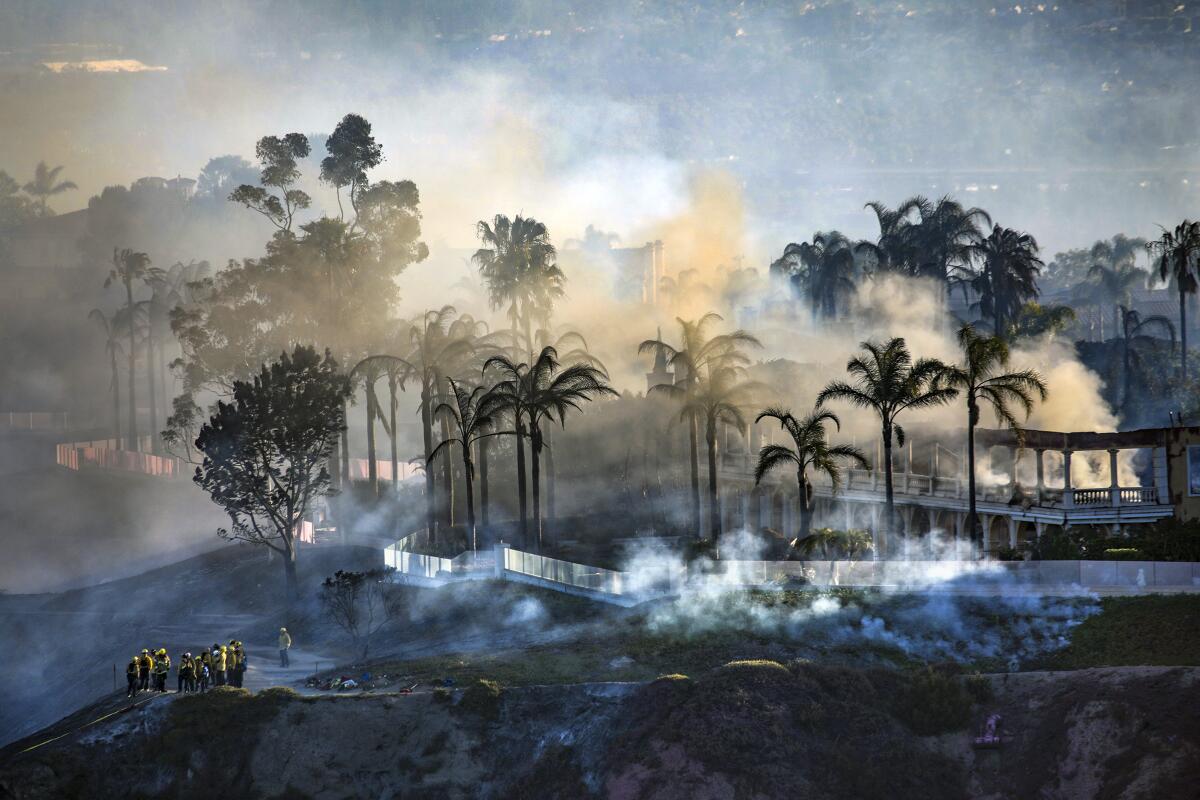
Firefighters had to make decisions on the fly because the fire was moving so quickly. One firefighter described it as akin to a “fog of war”; it wasn’t even clear how long they’d been battling the blaze.
The fire was first reported to the Orange County Fire Authority at 2:43 p.m. A man at the South Orange County Wastewater Authority’s Coastal Treatment Plant called in a small blaze — just 50 feet by 50 feet — that was burning in Aliso Woods Canyon.
He told the fire dispatcher that a “power pole started the canyon on fire.” He said there was a downed power line, according to a redacted recording of the 911 call reviewed by The Times.
Fifteen minutes later, Laguna Beach Fire Battalion Chief Crissy Teichmann radioed OCFA to report that she had arrived at the fire scene near the treatment plant. It had grown to half an acre and was burning in medium brush.
She said they were going to have trouble getting hand crews out to the fire. The area has limited road access and rugged terrain. Teichmann requested air support, according to archived radio calls reviewed by The Times.
Three minutes later, she radioed that the city’s police department was evacuating the Ranch, an upscale resort and golf course in Laguna Beach.
Just before 3:45 p.m., the Orange County Fire Authority posted on Twitter that a 3-acre vegetation fire, dubbed the Coastal fire, was burning in the canyon.
The initial attack centered around stopping the fire in the flat part of the canyon, where the winds and the topography were not as extreme. Crews battled the flames on the ground, and helicopters dropped water.
But it wasn’t enough to stop the flames. The fire jumped Aliso Creek and began to burn on the hillside closer to Laguna Niguel homes.
Fixed-wing aircraft dropped retardant on the vegetation backing up to the homes to keep the fire away. Firefighters stood ready to defend the neighborhood.
Sean Doran, a spokesman for the Orange County Fire Authority, described the first tense efforts this way: “Despite the air tankers and helicopters aggressively hitting the spot fires on the hill, the steep slope, strong sustained winds, dry vegetation on the canyon walls and extreme thermal heat created a relentless ember cast.”
It “jumped over not just the retardant lines,” Doran said, “but also the neighborhood’s defensible space and the pre-deployed OCFA hose lines and firefighters...”
It was time to evacuate.
A helicopter hovered above the neighborhood making announcements over a public address system that the fire was approaching. Deputies went door to door to homes near Pacific Island Drive and Coronado Pointe, warning residents to leave.
The ocean breeze that cools the subdivision during warm summer days was fanning the flames. The fire was making a rapid climb toward homes at the top of the ridge, fed by vegetation left bone-dry by California’s years-long drought.
“Once the fire hit the base of the hill below the homes it was like an arrow that just shot to the top,” said Orange County Fire Authority Chief Brian Fennessy.
Severe drought, gusty winds and sloping topography were a devastating combination for this seaside housing development in Laguna Niguel.
Residents stuffed as many belongings as they could in their cars and fled as the flames licked their backyards. Some left with just the clothing on their backs, overwhelmed by the swirling ash and heat that threatened to overtake their tony neighborhood.
At 4:41 p.m., a man called 911 to report that he was watching the flames charge toward his home from a camera on his property on Vista Court.
“The fire is literally at our back door,” he told the dispatcher.
Around the same time, authorities requested that an additional strike team respond to Coronado Pointe and Pacific Island Drive. Fire alarms started blaring at three houses on Coronado Pointe.
The county sent out a mass notification to people’s phones in the evacuation area at 4:55 p.m.
Crews radioed to report the first homes in the neighborhood had caught fire.
Twenty miles away, at the Orange County Fire Authority headquarters in Irvine, Safety Officer Sean Colgan pointed his truck toward Laguna Niguel. As he drove, he could hear the chaos crackle over the radio.
“We’ve got another structure. I need more engines. I need help. I need air support.”
When he arrived in the neighborhood at 5:30 p.m., ash rained down, and thick gray smoke hung like a low cloud. At least a dozen homes were on fire.
Crews scrambled through the neighborhood trying to keep flames from jumping from one stately structure to the next.
“When I drove in, it was like watching something out of Universal Studios...” Colgan said. “I mean, just smoke, fire, debris, facades falling in front. It was utter chaos.”
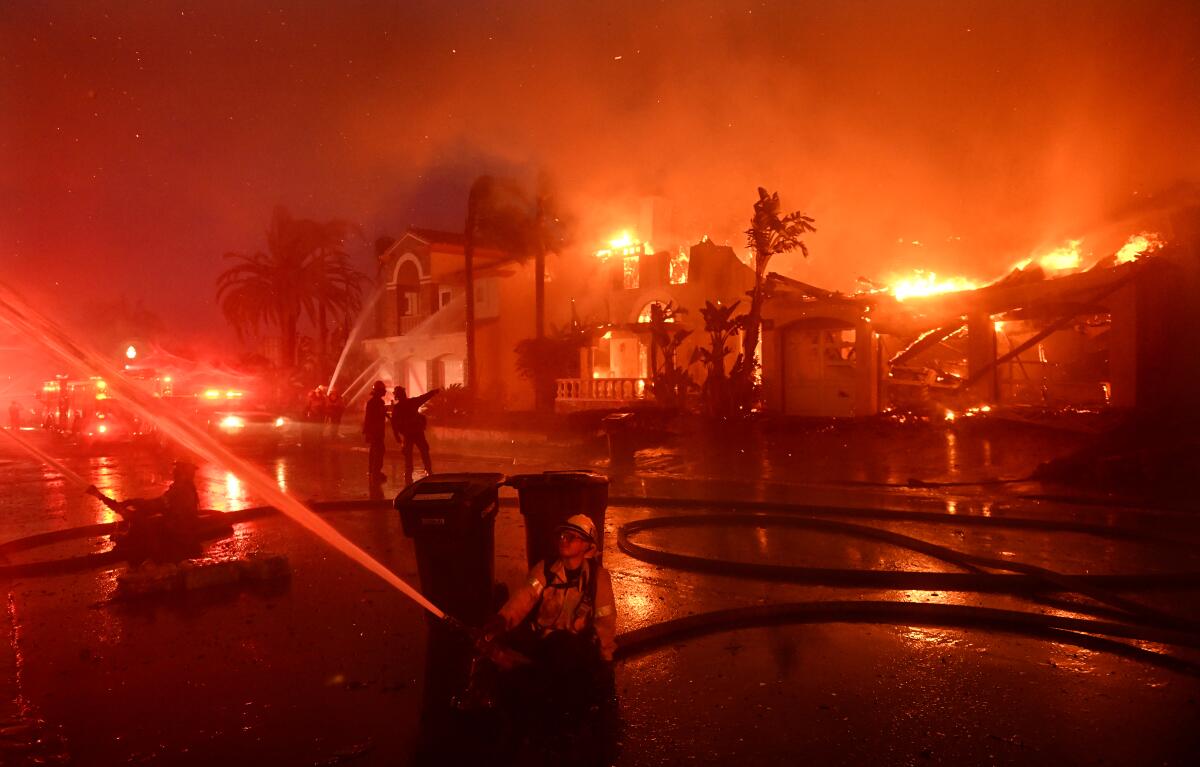
Homes on both sides of Coronado Pointe were engulfed. The flames illuminated them from the inside, casting a bright, orange glow. The smoke was so thick firefighters could barely see, Colgan said.
The 30 mph coastal winds cast embers across the neighborhood, blowing them into attic vents and burying them deep into roofing material where they smoldered and caught fire. Smoke poured out of vents and chimneys.
Fire trucks lined the street with hoses spewing water in all directions.
Firefighters positioned themselves anywhere they could to try to get the upper hand. Some stood in doorways, shooting water through blown out windows as flames raged inside.
Others dragged heavy hoses into threatened houses and shot water out of second story windows to get a better angle on a fire next door.
“We were having to pull people away because we had buildings collapsing toward the firefighters,” Colgan said.
While some focused on homes that were fully engulfed, firefighters also sprayed down adjacent properties to prevent embers from igniting them.
Helicopters charged overhead to drop water. Aircraft dusted the neighborhood with pink fire retardant.
“Everybody’s screaming for more water and more lines,” Colgan recalled. “They’re doing everything they can, using every tactic they can think of.”
When one strategy wasn’t working, the crews would brainstorm and try something else. Decisions were swift, as firefighters desperately tried to triage the fire’s spread, Colgan said.
Duke Juarez, a safety officer with the Orange County Fire Authority, said his eyes burned from embers flying through the air.
Juarez’s main task is to keep firefighters safe. But he also entered burning homes to make sure no one was left inside. If he could, he said, he would grab some personal items on his way out.
Around 6:30 p.m., Juarez watched as smoke poured from the roofline of Lynn Morey’s five-bedroom rental. The inside of the house was thick with smoke, and the heat on the second story told Juarez what he needed to know. The attic was burning.
“Once I went upstairs, it was like an oven,” he said.
Soon the entire home was engulfed — a façade and some stone work in the front yard the only remnants of the once grand property. On his way out, Juarez grabbed a silver frame that contained a photograph from Morey’s wedding and an Apple desktop computer.
The photograph was taken in 2017, as Morey and her husband, Keith, stood on a hillside overlooking the ocean and exchanged vows.
“On my way out I was thinking, ‘What can I grab really quick?’ and I saw the picture,” he said. “Then I looked over one of my shoulders and saw an office with a computer.”
The homes burned until the early morning, casting the neighborhood in an angry glow. Some who’d gotten to safety watched the news as flames consumed their houses.
Morey stayed nearby, watching at a distance from a hillside, wondering for hours if her home was still standing. She had been out running errands when the fire reached her neighborhood and was unable to get inside to grab any belongings.
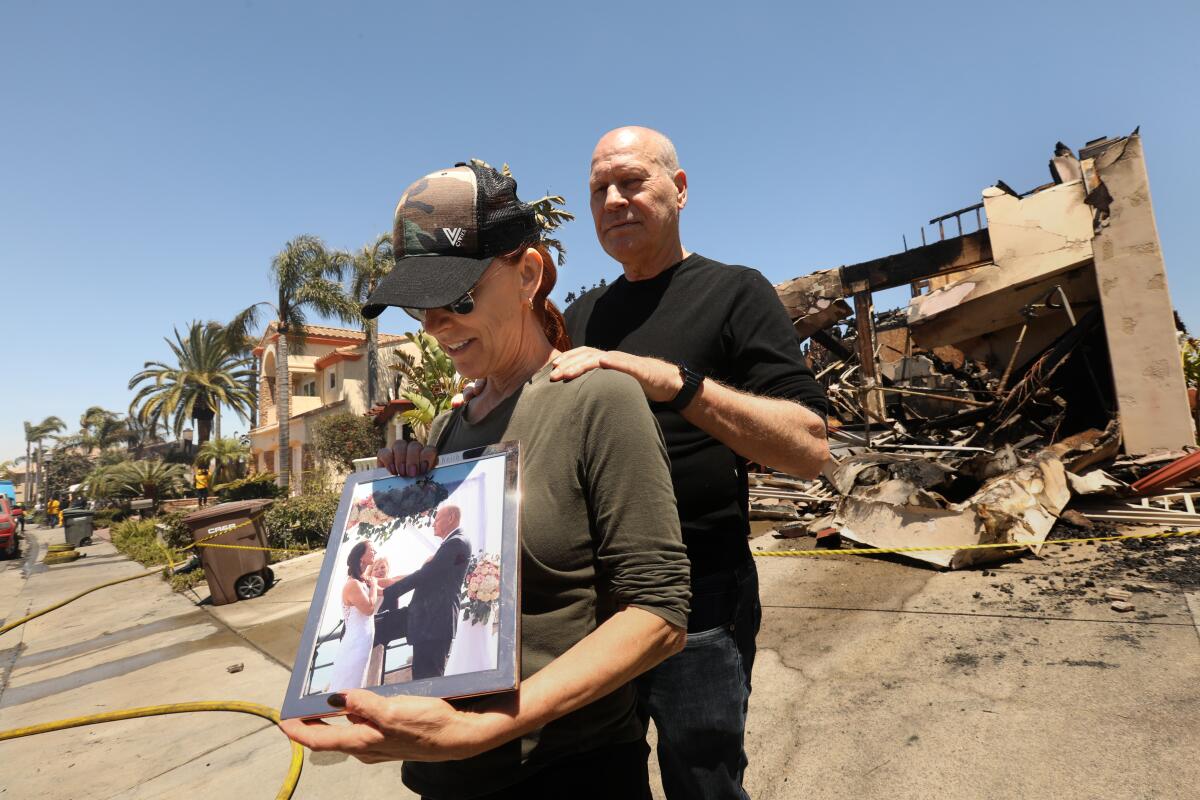
The next day, she returned to her devastated street and saw what was left of her home: The interior was completely destroyed. The second story and roof were gone. The charred remnants of her car sat inside the garage. The once white shutters that framed her windows were blackened from the relentless flames.
A firefighter handed her the photograph. She clutched it — a memory of one of her happiest days — as she took in the destruction in front of her.
It was May 12, her late sister’s birthday.
Morey said she saw the saved photograph as a sign her sister, who had lived in the home with Morey, was still looking out for her.
“I think she brought this as a gift,” Morey said, looking at the memento.
Laguna Niguel residents return to ruins: ’30 years worth of memories’ up in flames
After two decades on the job, Juarez said, it never gets easier watching people lose not only their belongings but also the memories they made inside their homes.
He said he only wishes firefighters could have done more.
The morning after the blaze tore through, firefighters sprayed down the still-smoldering contents of homes up and down the street. Residents walked tentatively through the neighborhood to see whether their home survived the night.
Many cried. Some stood solemnly, vowing to rebuild.
Investigators are working to piece together the fire’s origins. Southern California Edison issued an initial report to state regulators saying there was “circuit activity occurring close in time to the reported time of the fire.”
Residents filed a lawsuit in Orange County Superior Court in May claiming the fire was sparked by the utility’s “negligently operated, repaired and maintained electrical equipment” and failure to clear brush around the equipment.
The graduation party for Frank’s nephew was rescheduled, but his home was spared. And on this day, he couldn’t help but feel a little guilty.
“It’s horrible. It just seems so random when you look at which houses survived and which didn’t,” he said. “I’ve never seen such destruction before.”
The fire swept through an upscale neighborhood on May 11, spurred by robust coastal winds and dry brush starved of moisture due to a drought gripping the West.
More to Read
Sign up for Essential California
The most important California stories and recommendations in your inbox every morning.
You may occasionally receive promotional content from the Los Angeles Times.
